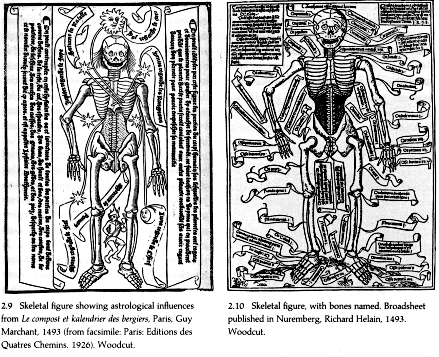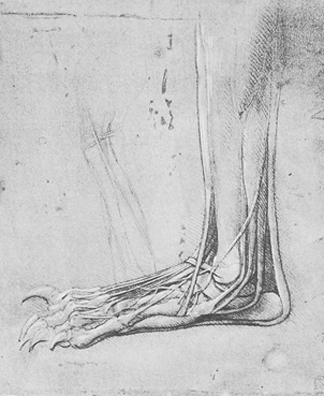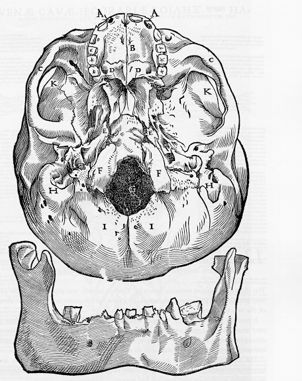A HISTORY OF THE SKELETON
![]()
Introduction
Physicians from antiquity through the Renaissance discussed the form and function of the skeleton in their writings, yet didn't view their discoveries as overly noteworthy. Beginning with Galen, the investigations of the skeleton followed a certain pattern. Physicians were primarily impressed with the hardness of the bone. Shortly after noticing the hardness, they would comment on the role bones had in maintaining structural integrity. The final semi-enthusiastic declaration was how the bones provided protection for the body's softer areas like the brain or heart. Each succeeding generation after Galen relied heavily upon his knowledge and added relatively little original discoveries. The comments from Galen, Avicenna, the pre-Vesalian anatomists, Leonardo da Vinci, Jacopo Berengario da Carpi and William Harvey reveal that these medical authorities understood what the skeleton did for the body to a large extent. The lack of mystery about bones, as compared to the greater mysteries within the body, caused them to overlook much beyond the fact that bones provide protection and structure for the body, or that they are just plain hard.
Questions to consider: Why was the skeleton seen as a less interesting object for investigation compared to other parts of the body?
A Collection of Quotations from Original Sources and Images of the Skeleton:
Antiquity
Galen, 200 A.D.
"To protect the system completely, it was better for it to consist of many bones, and further, of bones just as hard as they are."
"Now the encephalon had to be protected by a strong enclosure and Nature consequently did not merely entrust its defense to the skin, as she did for the parts in the abdomen, but first, before the skin was put on, she invested it with bone like a helmet."
"The femur has with good reason been made the largest of all the bones in the body, for it is fitted directly into the acetabulum and is the first bone to sustain the whole weight of the body above it."
"Wherever bones must articulate with one another, particularly if the bones are large, one bone necessarily receives the other, which enters it, and the one that receives needs a concavity, and the one that enters, a convexity."
The Middle Ages

Avicenna, 980-1037
"The skeletal system is predominantly composed of Earth."
"The external configuration of the body, including the physiognomy, is a reflection of the functional capacity of the internal organs and general make-up of the individual. Every detail of the physique, length of limbs, of fingers, contours etc. are all part and parcel with the functional conformations of the viscera, and the mental characters."
"In the case of bone, the equable temperament has dryness more than other qualities. Each organ and member has also received the proper temperament requisite for its function."
"The bone: this is the hardest of all the members. It is however moister than hair, because bone is derived from the blood, and its fume is dry, so that it dries up the humours naturally located in the bones. This accounts for the fact that many animals thrive on bones, whereas no animal thrives on hair-- or at least it would be a very exceptional thing if hair ever did provide nourishment. The proof that bone is moister than hair is that when equal weights of bones and hair are distilled in a retort, more water and oil will flow and less "faex" will remain.

Jacopo Berengario da Carpi, 1460-1530 (illustrations from Da Carpi's text)
"This is properly called the hand, so called from emanating, because from this part almost all handicrafts emanate. Between this and the second part is a juncture composed of many bones called in Arabic raseta and ascam and in Greek carpus."


"The ribs are attached to the twelve first vertebrae below the neck and to the aforesaid bones of the chest and the panniculi covering them. Their complexion is cold and dry. Their services are evident. They suffer all kinds of ills. Their anatomy would best see you if you could turn your attention to them alone in an individual, paying no attention to spiritual members."
"The posterior bone is harder because the posterior contents are harder. The posterior bone is also harder because the eyes cannot protect it with their sight."
Pre-Vesalian Anatomists
"The cranium is a large bone covering the brain on the outside; it is woven together with the junctions called adoreae, that is, sawlike, through which vapor or smoke goes forth and the sinewy fibers from the aura mater."--Alessandro Achillini, 1520
"There are thirty vertebrae. But the round bone upon which the head rests makes thirty-one when it is included in the number of the vertebrae. There are seven vertebrae of the neck; they are slender but have a larger cavity or aperture, however, and are hard and firmly joined to each other. Or does the tenth vertebra have two pieces or processes? Or do the processes ascend above and descend below the tenth vertebra? Or does the tenth vertebra have two cavities?"--Alessandro Achillini, 1520
"In the larger hand there are thirty bones, there would be thirty-one if the ninth of Galen was included, but that, however, is a monkey bone."--Alessandro Achillini, 1520
"The bones of the arms and legs and the ribs arise from the spine, hard, stable, heavy, as the firm foundation of the entire body. For this reason they are stiff and dry, without sensation, since otherwise they would be continually subject to pain. "--Alessandro Achillini, 1520
"Some bones either protect the body, such as the skull, ribs, radius, or ward off objects that strike, such as the spinous processes of the vertebrae, or fill out empty spaces, as the bone which they call the patella in the knee. Others are more solid and most strong, some are perforated such as the cranium, some are full of marrow for nourishment."--Alessandro Achillini, 1520
"All the bones are covered with a membrane or periosteum. When this is torn away they are straightaway destroyed, nor do they have sensation without it, since they are cold (as has often been stated) and dry of nature."--Alessandro Achillini, 1463-1512
"It is very clearly apparent from the admonitions of Galen how great is the usefulness of a knowledge of the bones, since the bones are the foundation of the rest of the parts of the body and all the members rest upon them and are supported, as proceeding from a primary base. Thus if any one is ignorant of the structure of the bones it follows necessarily that he will be ignorant of very many other things along with them."-- Niccolo Massa, 1559
"Nature has made the spine for animals to be like the keel of the body that is necessary for their life; for it is thanks to the spine that we can walk erect and each of the other animals can walk in the posture that is the better one for it..."-- Nicolo Massa, 1559
Leonardo da Vinci, 1452-1519 (illustrations from Da Vinci's text)
"Make a demonstration of these ribs in which the thorax is shown from within, and also another which has the thorax raised and which permits the dorsal spine to be seen from the internal aspect. Cause these 2 scapulae (spatole) to be seen from above, from below, from the front, from behind, and forward."



Other Renaissance illustrations:



William Harvey, 1543
"On each side twelve ribs, seven true, the rest false, short; by degrees shorter as the body is bent at the sides; without compression lest it press the intestines."
"Long neck in men is a sign of timidity, if subtle, of weakness, as some stags have a long neck (seven vertebrae). Short and thick neck signifies steadfastness, headstrong, stubbornness.The sign of a cuckold is perhaps a very long and rounded neck, the sign of a cold brain and of a temperament which is impotent for venerity and timid."
"There are three uses for the sternum: rampart for the heart and vitals, binding for the ribs, support for the membranes of the mediastinum. Sometimes it protrudes outward, out cheated, origin of gibbosity. The sternum is made up of 6 or 7 bones, more in children and fewer occur in old age."
"Sutures of the skull act as breathing devices of the cerebrum, of expansion."
Conclusion